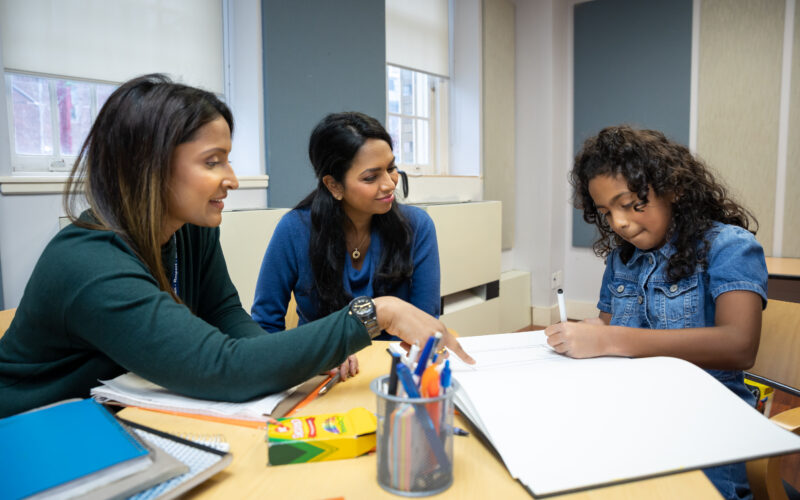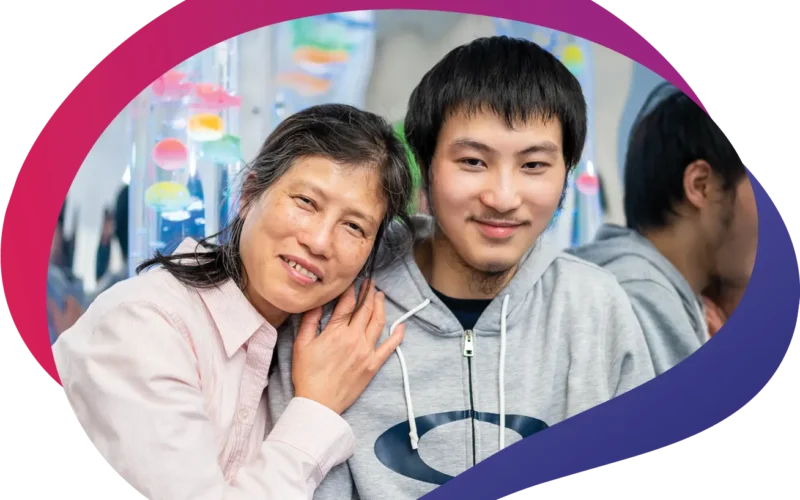Guiding Your Family Through Our Programs
Every child learns in their own way. At Surrey Place, At Surrey Place, our Applied Behaviour Analysis (ABA) Group Therapy and other autism grop programs are designed to meet children where they are, helping them build real-life skills in communication, social connection, and emotional regulation. Whether you’re just starting your journey or looking for the next step, we know choosing the right program can feel overwhelming. That’s why we’re introducing you to some of the children in our programs to help you see where your child might fit and how, with the right support, they can grow, connect, and thrive.
See How Children Like Yours Are Thriving
Meet Alex, Bella, Chris, and Dana—four children who, like so many we work with, are learning to connect with others, express themselves, and feel more confident in everyday life.
Alex, Age 4
Alex is a bright and curious child who recently received an autism diagnosis. He loves sensory toys, music, and stacking blocks. While Alex enjoys being around familiar people, he often feels frustrated when he can’t communicate his needs. Alex mostly communicates by pointing, leading adults by the hand, or using a few simple sounds but they’re beginning to imitate single words and show interest in learning new ways to express themselves.
Recommended Programs for Children like Alex
- Connect & Play Interdisciplinary Group, an engaging program where caregivers and children participate together in playful activities that support communication, social connection, and early learning. Led by a team of specialists from ABA, speech-language, and occupational therapy, this group helps children like Alex build confidence in expressing themselves while strengthening the caregiver-child bond through music, movement, and shared fun.
Bella, Age 7
Bella is a joyful and imaginative girl who loves animals, bubbles, and listening to stories. Bella speaks in short sentences and can express basic needs independently but finds social interaction difficult. She often wants to play with other kids but isn’t sure how to join in. She often hovers nearby and feels overwhelmed by noisy or unpredictable situations.
Recommended Programs for Children like Bella
- Your child may be suited for Social Stars, a program that helps children learn to be around peers and connect with others by practicing essential social skills such as greetings, turn-taking, sharing, and parallel play.
- Early to Intermediate Communication can support in expanding language skills—teaching how to request new items or activities, respond to gestures, label objects, ask for help, and answer basic questions using single words or short phrases.
Chris, Age 10
Chris is a bright and imaginative boy who loves trains and dinosaurs. He speaks in full sentences and has a strong vocabulary, often sharing detailed facts about his favourite topics. While Chris is eager to connect with others, his conversations tend to be one-sided or jump between topics. He may interrupt, miss non-verbal cues, or dominate discussions without realizing it. Chris wants to make friends but finds it hard to stay on topic and recognize when others are confused or disinterested.
Recommended ABA Programs for Children like Chris
- Try Conversation Club, where your child can practice starting and maintaining conversations, taking turns speaking, staying on topic, and reading important social cues like facial expressions or tone of voice.
- They may also benefit from Take a Deep Breath, a program that teaches children how to identify their emotions, calm their bodies, and manage stress in social situations—helping them navigate conversations and peer interactions with more confidence.
Dana, Age 15
Dana is a thoughtful and articulate teen who excels in school but often feels lost in peer interactions. She communicates well with adults but finds it hard to deal with subtle social dynamics like teasing, peer pressure, or sarcasm. Dana wants to make real friendships and is learning how to advocate for herself while reading between the lines of teen conversation.
Recommended ABA Programs for Teens Like Dana
- Your teen may thrive in Working Together, a group that supports teens in building perspective-taking skills, learning to collaborate with others, and practicing negotiation and teamwork in both social and academic settings.
- Another great fit is PEERS, a social skills program where participants learn how to make and maintain friendships, use humour appropriately, and respond effectively to teasing, gossip and peer pressure
Not Quite Ready for a Group? That’s Okay.
Some children may benefit from individualized support before joining a group. These 1-to-1 services help build key skills and confidence in a personalized, supportive setting.
- Full Day ABA (IBI) provides intensive, one-to-one Applied Behaviour Analysis designed to support children with high needs across multiple areas of development. This comprehensive program focuses on building foundational skills in communication, behaviour, self-care, and is more tailored to each child’s unique profile.
- 1-to-1 Focused Behavioural Intervention offers customizable, short-term ABA support that targets one or two specific goals. Whether it’s helping your child learn to brush their teeth, sit through meals, or manage transitions, this program is designed to meet immediate priorities with personalized strategies.
Finding the Right ABA Group Program for Your Child
Every child develops at their own pace. That’s why Surrey Place offers a wide range of ABA Group Therapy programs that are flexible and tailored to meet your child’s current strengths while building skills that matter most in everyday life.
Why Families Trust Surrey Place
- Small Group Sizes: We maintain small group sizes to ensure personalized attention for each child while maximizing the benefits of group dynamics.
- Expert-Led Group Sessions: Our group therapies are facilitated by highly trained professionals who specialize in ABA Therapy and have extensive experience working with children and teens across the autism spectrum.
- Focus on Real-Life Skills: Programs emphasize practical skills such as managing peer pressure, handling disagreements, and navigating social complexities, preparing your child for everyday situations.
- Peer Interaction and Socialization: Group settings provide a unique opportunity for your child to interact with peers, fostering essential social skills like communication, cooperation, and empathy in a real-world environment.
- Proven Success Stories: Many families have seen significant improvements in their children’s social abilities and confidence through our group therapy programs.
Families trust us because they see real changes at home, at school, and in their child’s confidence.
Dr. Nancy Freeman, Director, Autism Behavioural Services
Ready to Empower Your Child’s Progress?
Whether you’re looking for a first step or next step, our ABA Group Therapy programs are here to help your child gain skills, confidence, and independence.


